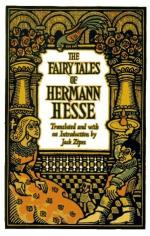|
This section contains 898 words (approx. 3 pages at 300 words per page) |

|
German dualism shows itself in the young Hesse in the serious struggle between mind and matter, spiritual and physical life. The young Hesse longs for the simple, the unsophisticated. His most famous fictitious character, Peter Camenzind, gladly gives up art to be a child of nature, living close to lake and mountain. Peter Camenzind, published in 1904, is, to a degree, autobiographical: Hesse has always lived in small villages hidden somewhere in the mountains. Autobiographical too is Hesse's next novel, Unterm Rad ("Under the Wheel"), the story of a theological student who breaks down under the strain of study. There is a rebellious spirit in these early novels, a revolt against oppression by parental and professional authority, against the soul-killing tutelage to which modern society subjects the individual. Other novels, like Gertrude (in English "Gertrude and I") and Rosshalde, mirror the rebellion of an artist, a musician, and a...
|
This section contains 898 words (approx. 3 pages at 300 words per page) |

|


